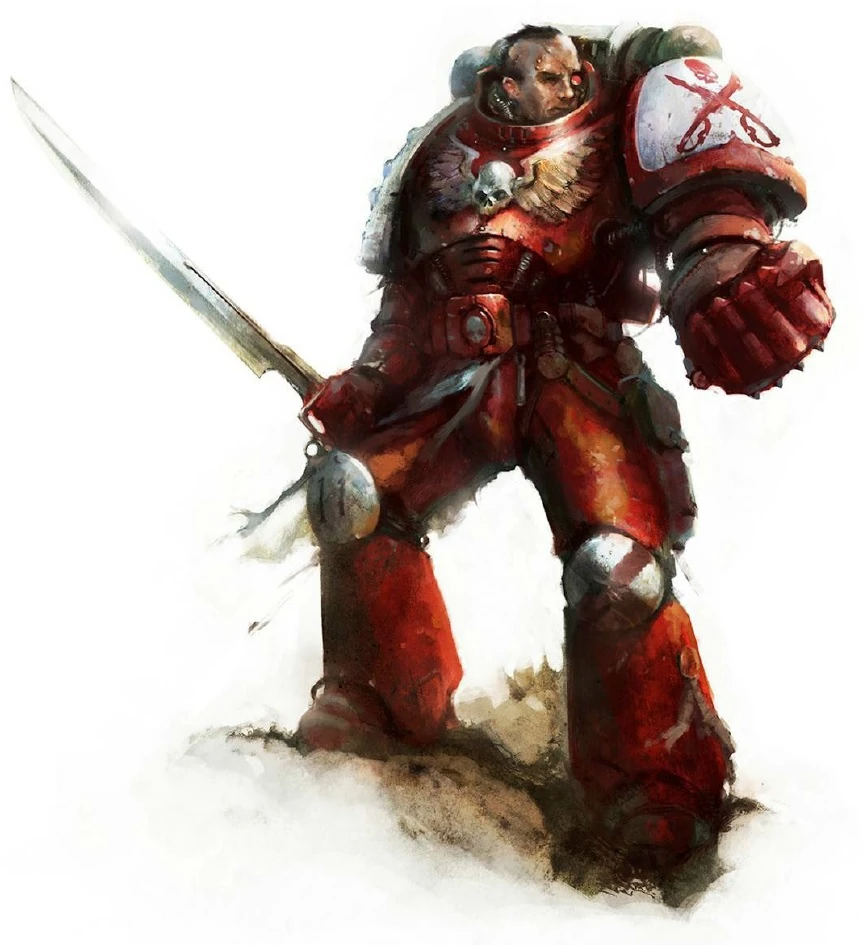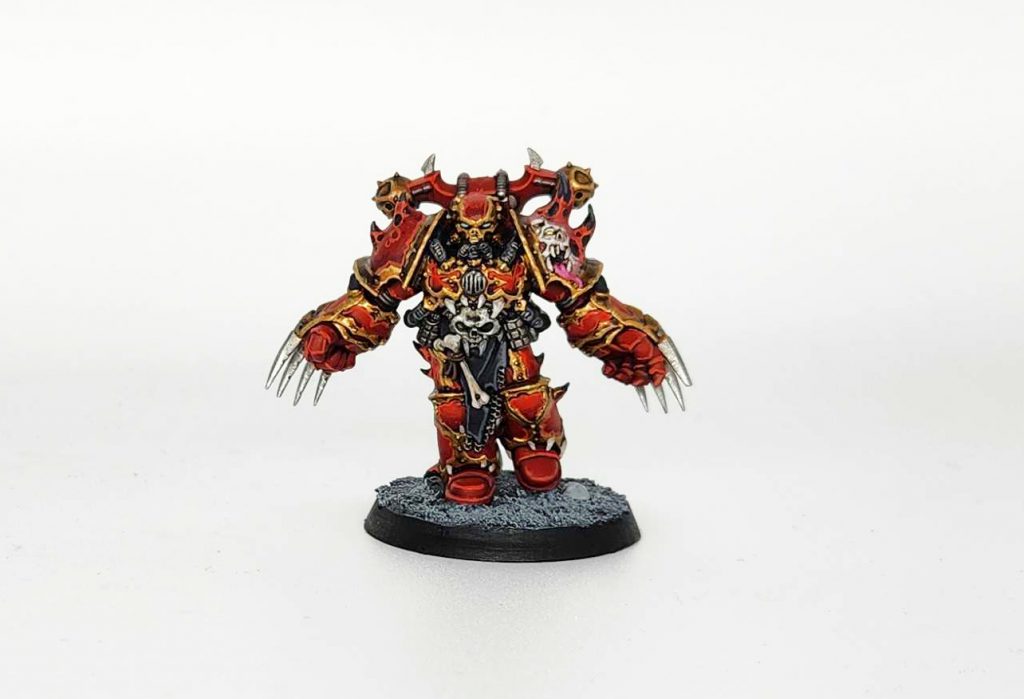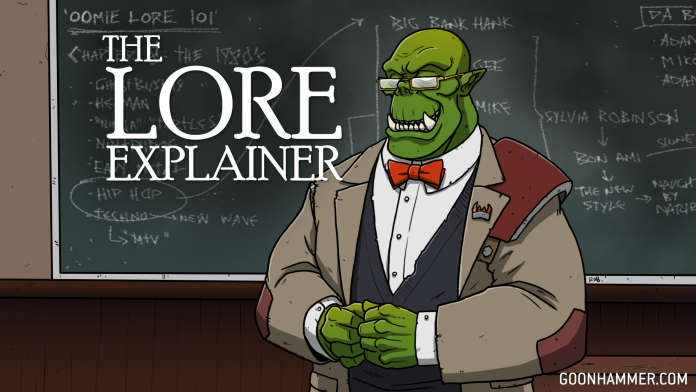In The Lore Explainer, we take a deep look at the lore behind our favorite games, movies, and books, and talk about the story behind them and sum up what you need to know and how you can find out more. In this article we’re looking at the lore behind one of the most famous renegade chapters, the Crimson Slaughter.
When the 6th edition of Warhammer 40k launched, it did so with Dark Vengeance, a boxed set featuring a clash between Dark Angels and Chaos Space Marines. Though instead of featuring the more (in)famous forces of the Black Legion, Word Bearers, or Red Corsairs, the boxed set featured a renegade chapter of space marines clad in red and gold armor known as The Crimson Slaughter. The Crimson Slaughter had their own named characters and backstory and were an entirely new subfaction of Chaos Space Marines, showing how even the vaunted protectors of humanity could fall from grace.
Since then, the Crimson Slaughter have received their own supplements in 6th and 7th edition and rules in 8th edition 40k. And while they’ve fallen out of style and are no longer the poster children of the faction, the Crimson Slaughter are still an interesting note in the lore of 40k. Aside from the Red Corsairs, they are the most well documented of the renegade chapters. So join us as we talk about the history of the Crimson Slaughter and what their story means in the larger context of 40k.

The Crimson Sabres
The story of the Crimson Slaughter starts with the Crimson Sabres, a loyal space marine chapter of an uknown founding. The earliest records of the Crimson Sabres place them taking part in battles during the Age of Apostasy, fighting off Xenos threats while the Imperium reckoned with the internal crisis posed by Goge Vandire. During this time they’re described as being a Codex-Compliant chapter of exemplary martial prowess and discipline.
The Crimson Sabres made their home in the Brakatoa system, a region of space once plagued by warp storms. Although these storms had abated the area remained particularly hazardous to warp travel, leading to it to gain the name “Hulk Alley.” One of these hulks was the massive Amalgamation, at the center of which was a pilgrimage ship populated by millions of colonists who were under siege by warp entities and calling for help.
To answer these distress signals the Crimsons Sabres were called into action, along with the Dark Angels and Blood Angels. While all three chapters boarded the vessel, the Crimson Sabres boarded first, without waiting for their more august brethren to lead the action. Together the chapters purged the vessel of daemons, but the Dark Angels and Blood Angels got pretty pissy about being disrespected by a younger, less respectable chapter. here was also some drama with the Dark Angels, who captured and interrogated a colonist and were caught doing so by the Crimson Sabres, leading to some heated disagreements that actually came to blows and would have been worse had the Inquisition not shown up, causing the Dark Angels to back off lest the secret of the Fallen get out to someone else.
These minor injustices would lead to the Crimson Sabres being censured by Terra following the incident, something that didn’t sit well with their leadership. This led to the chapter declaring that they’d only answer to directives from holy Terra from then on, but the seeds of doubt had been planted and many in the chapter feared further censure. While outwardly the chapter managed to rebrand itself and shrug off this indignity, inwardly, bad things were brewing.
As the Crimson Sabres continued to adhere most closely to the Codex Astartes, they started getting self-righteous and petty. After major actions and campaigns they’d issue reports chastising their fellow marine chapters for their sloppiness or failure to adhere to the Codex Astartes. If this sounds tedious to you, well it was just as tedious to their allies and they soon became estranged from other chapters and imperial forces. While their reputation back on Terra was exemplary, other chapters felt they were overly suspicious and hypercritical, and would generally talk shit about them. The Crimson Sabres became more and more fixated on the idea that the overall perception of them was negative.
As it would happen, while they were off on one of these big crusades with the majority of the chapter, their home world (and most of its system) were attacked and completely wrecked by a daemonic incursion. Their world and two others were declared exterminatus, forcing them to relocate their fortress monastery to a different world in the system. It would take years for the chapter to rebuild its strength.
The Massacres at Umidia and Demetra
Over the next thousand or so years the Crimson Sabres would rebuild and in the process become more and more isolated and estranged from their allies, who mostly just saw them as condescending dicks. So when a distress call went out from the planet Umidia and the Crimson Sabres answered, other chapters opted to stay home and let them handle it solo rather than deal with them.
What the Crimson Sabres found on Umidia was a planet which, to the man, had fallen into the worship of Chaos, becoming gibbering madmen beset by voices. Calling for aid from the entire chapter, the Sabres followed the dictates of the Codex to the letter and eradicated every single living citizen on the planet. Later when the Inquisition would investigate the planet they’d find no evidence of chaos cults, only a planetwide scene of grisly slaughter.
Following the massacre, the marines of the Crimson Sabres found they were unable to clear their minds or put out the scenes of carnage they had wrought. They began to hear voices – whispers in the voices of those they had murdered taunting them and screaming at them. They began to call this phenomenon The Haunting. This drove them mad and by the time they returned to Umidia’s sister planet, Demetra, to find proof of the cults and their innocence, they’d descended into madness. The Crimson Sabres fell upon the planet and killed everyone, finally silencing the voices in their heads. They declared the planet tainted by Chaos and moved on.
Excommunicate Traitoris
None of this went over well with the Inquisition and the High Lords of Terra, who declared the chapter Excommunicate Traitoris and decreed that Imperial forces should kill them on sight. The Crimson Sabres’ Chapter Master, Sevastus Kranon, knew the jig was up at this point; they could never explain what they had done, and even if they had a chance, saying they’d done it to quiet the shrieking voices in their heads would have just led to them all being executed as chaos-tainted madmen. Kranon gathered his librarians and fired off a final message to their homeworld, telling their remaining chapter personnel to get the hell out of Dodge, and then he addressed his chapter.
Kranon’s idea probably seemed pretty solid to the fanatics in the room with him: If they were going to be branded traitors, they should make for the Eye of Terror, where they could fight the traitor legions and go down swinging without the loss of any more innocent life. By doing so, they could hopefully atone for their wrongs and continue to carry out the Emperor’s will. One last campaign, this time striking at the heart of the enemy. Of course, if you were on the outside looking in, you’d just see a renegade chapter fleeing to the Eye of Terror where all the other renegades live.
That particular voyage wasn’t great – Warp Travel made the voices of the Haunting worse – and breaking into the Eye of Terror was not a trivial task. The chapter’s fleet was attacked by Imperial Fists en route to the Eye and forced to defend itself, managing to escape with a single, damaged flagship. Still, they made it, and descended upon the fringe worlds of the Eye with a fanatical zeal, quieting the voices in their heads by slaughtering chaos cultists and mutants.

The Descent
Falling to Chaos wasn’t a single moment for the Crimson Sabres, but rather a series of gradual steps as their crusade took them deeper into the eye. Their methods of warfare became more brutal. The litanies of their chaplains shifted. The signs of corruption became visible, with fangs here and glowing eyes there. These alterations would become acceptable to the chapter, tools in their war against Chaos. Some members of the chapter would eventually come to their senses or speak out against this, only to be imprisoned within the ship’s bowels, where they’d slowly go mad.
At some point the chapter’s librarians went to check their logs and had a grim realization: The records they’d been keeping of their crusade were just screaming gibberish and mad ravings, not the detailed records they thought they’d been broadcasting to the Imperium as a way of, if not clearing their names, at least buying them some redemption in the eyes of the imperium.
This was essentially the last straw for Chapter Master Kranon, who had a long think about what their situation was and decided he wasn’t really interested in dying a noble death any more but instead wanted to live. Note that this was also what the voices in his head had been screaming at him, but he’d convinced himself what he’d wanted.
The good news was, his chapter felt the same way (for similar reasons), and decided they were no longer into martyring themselves for an ungrateful Imperium. They’d find a cure for the curse that had befallen them and they’d no longer follow the dictates of Terra. The chapter purged its remaining loyalist members and became a warband – the Crimson Slaughter.
Note: The fourth company of the chapter fled at this point, seizing one of their ships and returning to Imperial Space. They returned to the chapter’s irradiated homeworld and operate out of there in secrecy, hoping to restore the chapter’s honor. They still bear the heraldry of the original chapter.
Changing Sides in The Long War
So Chapter Master Kranon became Kranon the Relentless, perpetually driving his warband onward to new slaughter to silence the raving voices in their heads. The warband itself would become known for being Haunted – not just mentally, but physically as well. Strange phenomenon would occur when the Crimson Slaughter were near – skies bleed, walls melt, and strange ghosts and apparitions emerge from the shadows, and people are assailed with horrific visions and voices of their own.
Eventually the Crimson Slaughter would make a deal with Fabius Bile, trading their incarcerated former brothers for his aid creating new marines to replenish their numbers. They’d gain new clone-vats for building organs and would begin to recruit new members from the cultists and fanatics attracted to their wanton slaughter. By the time they returned to realspace for their first raid, they did so with the strength of an entire chapter once more.
Dark Vengeance
The Crimson Slaughter returned to the Imperium looking for a relic called the Hellfire Stone. Instead they ended up coming across Cypher and another Fallen. While Cypher managed to escape, they captured the Fallen, discovering his name was Turiel and essentially learning the Dark Angels’ whole backstory in the process.
Finding out that his chapter had been excommunated for a simple (genocidal) misunderstanding while the Dark Angels had a whole half of their legion turn traitor and could just keep it under wraps made Kranon pretty upset. Using Turiel’s intel on a hidden enclave of Fallen they lured the Dark Angels into a trap, killing a great number of the chapter in the process, including the 5th company captain (who will later be replaced by Lazarus). This did not go over well with the Dark Angels, who swore revenge. They’d eventually get it by preventing Kranon from completing the ritual to create the Hellfire Stone.
The Dark Angels and Crimson Slaughter would clash several more times, with the most notable battle being on the planet Numarc. Once again the Crimson Slaughter laid a trap for the Dark Angels, this time killing a great number of them and extracting their gene-seed to create new marines for their warband while ransacking their armories. It was during this time Kranon discovered that his librarian had been possessed and replaced by a Lord of Change, the daemon Tzax’Lan-Tar, and swore to destroy the daemon for its manipulations of the warband.
The 13th Black Crusade
Abaddon the Despoiler would eventually take note of the Crimson Slaughter and they’d swear fealty to the Warmaster, taking point in the 13th Black Crusade and sowing terror in the Imperium in advance of the Warmaster’s true forces arriving. The Crimson Slaughter opened the actions with an assault on the Diamor system, specifically the planet Amethal. Their initial raid was very successful, though they were ultimately driven back by Death Company reinforcements. They’d suffer massive casualties and barely make it off the planet alive, though ultimately their sacrifice was a valuable one to the Despoiler – they’d managed to activate an artifact called the Banshee Stone, weakening the walls of the Daemon Cage, a series of wards which helped keep the Immaterium at bay in the system. Weakening these wards would play an important role in birthing the Cicatrix Maledictum.

Final Thoughts
There’s quite a bit of backstory on the Crimson Slaughter for a faction as new as theirs, particularly given they aren’t particularly important to the larger narrative. Having your own standalone supplement will do that. What they do offer is a very interesting portrait of how a loyal chapter can fall to Chaos, even as it believes itself to be doing the right thing. If you’re interested in reading more, the 7th edition Codex Supplement: Crimson Slaughter has a ton of info on the warband’s backstory, while the Dark Vengeance novel goes into full detail on their clash with the Dark Angels post-fall. The most recent lore on the warband is in the 7th edition campaign supplement, Traitor’s Hate.
Since then, the Crimson Slaughter have been pretty quiet, taking a major backseat to the original traitor legions. They got some mention in Vigilus, though even there they played second fiddle to the Red Corsairs, Purge, Scourged, Brazen Beasts, and Flawless Host. I suspect it’s only a matter of time before they show up again, though it’s hard to say how popular they are – fan reaction to the faction was mixed. Longtime Chaos fans didn’t like a new upstart chapter getting its own rules before the legions, and the association of the warband with 6th and 7th edition rules doesn’t help create feelings of nostalgia for the faction.
Still, they’re an interesting group with some interesting backstory, and it’s worth giving them a look. The rules they did have were pretty interesting and flavorful, and there were a few recurring characters in the mix besides Kranon.
Have any questions or feedback? Have some lore you think we should dive into/ Drop us a note in the comments below or email us at contact@goonhammer.com.



You must be logged in to post a comment.